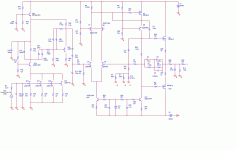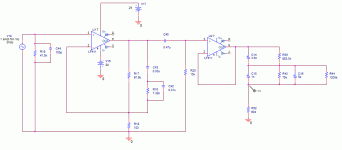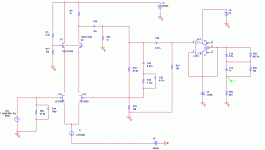analog_sa said:
3) Sounds better without cascoding, at least to my ears.
4) Loses a coupling cap in a very sensitive place.
A common cathode FET (paralleled if required), powered by either Jung reg or batteries is very close to the ultimate SS MC stage soundwise. And there is no need for a monstrous coupling cap.
hi analog,
thanks for your partecipation here too.
So you are telling me that in general it's beyyer a circuit without any cascoding? o you are just saying in this case?
I haven't understoond point 4. could you try, if possible to explain it again?
With your last sentence you mean that for the MC stage you would only use the paralleled 2sk170 without the cascoding and supplied by the Jung regulator?
If so i have read on the forum that people tried to eliminate the cascoding (basically making it a Pearl) and the sound was worse, but that could also depend upon personal taste.
Hi Rudiger
I will try all 3 options and report back as soon as possible.
I am very sorryyy but is till don't get the part as i didn't understand what analog tried to say by Loses a coupling cap in a very sensitive place"
Rudiger: do you mean by "I would try to design the coupling cap out" that you would try to redesign the MC last stage without the coupling cap C37?
I will try all 3 options and report back as soon as possible.
I am very sorryyy but is till don't get the part as i didn't understand what analog tried to say by Loses a coupling cap in a very sensitive place"
Rudiger: do you mean by "I would try to design the coupling cap out" that you would try to redesign the MC last stage without the coupling cap C37?
Stefanoo said:
Rudiger: do you mean by "I would try to design the coupling cap out" that you would try to redesign the MC last stage without the coupling cap C37?
Do you mind to reference the schematic? I seem to have a different one.
Rüdiger
Ok, thanks.
Yes, C37. I don't see an easy way to get rid of it, though.
The cap multiplier I was referencing to earlier is Q24 that further reduces possible ripple and the like on the supply line.
BTW, do you have a working circuit that performs anywhere near the ono right now? If not, you might not see an urgent urge to experiment that much after you build it
Rüdiger
Yes, C37. I don't see an easy way to get rid of it, though.
The cap multiplier I was referencing to earlier is Q24 that further reduces possible ripple and the like on the supply line.
BTW, do you have a working circuit that performs anywhere near the ono right now? If not, you might not see an urgent urge to experiment that much after you build it

Rüdiger
I was looking at Jung's website and i found an interesting article on RIAA's topology.
So i started to simulate the behavior of the basic RIAA active filtering and connected to at the output the inverse RIAA and run the frequency analysis.
The circuit (look at the attachment here) was simulated using an LF411 and it does simulate fine.
The problem is if i try to use instead of the OP amp i use a differential pair (look at the next post) i don't get the correct result.
I actually don't catch what it could be causing this.
If anybody can give me a tip on this i would really appreciate.
thanks
So i started to simulate the behavior of the basic RIAA active filtering and connected to at the output the inverse RIAA and run the frequency analysis.
The circuit (look at the attachment here) was simulated using an LF411 and it does simulate fine.
The problem is if i try to use instead of the OP amp i use a differential pair (look at the next post) i don't get the correct result.
I actually don't catch what it could be causing this.
If anybody can give me a tip on this i would really appreciate.
thanks
Attachments
where is C47 ?
are you referring to the schematic with the op amp or the second with the diff pair?
If, by C47, you mean the 10uF cap (C46) that is connected to the collector of Q1 is just the coupling cap and is just the feedback path from +Vout to -In of the differential stage.
Is it right?
are you referring to the schematic with the op amp or the second with the diff pair?
If, by C47, you mean the 10uF cap (C46) that is connected to the collector of Q1 is just the coupling cap and is just the feedback path from +Vout to -In of the differential stage.
Is it right?
One more observation:
I have run simulations for different values of the coupling caps on the MC stage, trying to substitute the 220uF caps with a 10uF first and a 30uF then.
I am not going to post this bulky posts here of coursebut i can report that there is a noticeable difference on the bottom end response by decreasing the values.
Therefore i guess i will go for the 220uF.
The point is that i don't like to have electrolytic caps on the signal path even though i would use a good rubycon (as far as i have read are far better than the blackgate).
Stefano,
I know this is pretty old stuff, but I'd appreciate very much any information on this.
I too am questioning my self if 220 µF are neccessary.
Stefano,
I know this is pretty old stuff, but I'd appreciate very much any information on this.
I too am questioning my self if 220 µF are neccessary.
Are you referring to the output coupling cap or to the extra DC zero?
The coupling cap is not needed if you have the star zero and you can simply trim output voltage.
You can also replace the zero with a servo.
I tried both solutions and I didn't like either one.

Stefano,
I have a Pearl I with the Ono MC pre-pre boards. These come with three 220 µF
coupling caps (Pana FC each parallel with a Pana PP). I plan to replace them with
Silmic IIs and obviously lower values would help greatly. In case of the 'last' one,
which is followed by the (Pearl's) MM input of 47 KOhm, a Wima MKS or even MKP
of some µF should do the job - at least to my guessing.
Thanks in advance.
I have a Pearl I with the Ono MC pre-pre boards. These come with three 220 µF
coupling caps (Pana FC each parallel with a Pana PP). I plan to replace them with
Silmic IIs and obviously lower values would help greatly. In case of the 'last' one,
which is followed by the (Pearl's) MM input of 47 KOhm, a Wima MKS or even MKP
of some µF should do the job - at least to my guessing.
Thanks in advance.
The three 220uF capacitors are a bit excessive for the task and you can easily calculate the cut off frequency of the high pass filter and you will see that a simple 100uF will do more than enough.
I am not sure whether Elena would be better sounding than Panasonic FC.
For the output coupling cap, I would take it off completely.
Do you have the big electrolytic installed on the feedback? If so, just use a trimmer to trim the output DC offset and you will be good to go.

I am not sure whether Elena would be better sounding than Panasonic FC.
For the output coupling cap, I would take it off completely.
Do you have the big electrolytic installed on the feedback? If so, just use a trimmer to trim the output DC offset and you will be good to go.

THX Stefano, highly appreciate your comments. Right, they're totally excessive,
at least the last one is. This is MC ono prepre sitting on top of the Pearl I:






Looking for this stuff I also found and older revision of this, where there was just
10 µF in the output section. I have no idea why Illias then changed it to 220 µF.




at least the last one is. This is MC ono prepre sitting on top of the Pearl I:






Looking for this stuff I also found and older revision of this, where there was just
10 µF in the output section. I have no idea why Illias then changed it to 220 µF.
10uF might not b enough and 680uF might be too much.
Nelson uses 220uF if I am not wrong.
What speakers table cartridge and power amp do you have?
Is your preamp cap coupled at the input and/or output?
Last,what kind of music do you listen to?
I am asking this to determine what could be best suitable for your set up and personal taste.
Nelson uses 220uF if I am not wrong.
What speakers table cartridge and power amp do you have?
Is your preamp cap coupled at the input and/or output?
Last,what kind of music do you listen to?
I am asking this to determine what could be best suitable for your set up and personal taste.
Built my Xono so I could bypass outputs. Didn't hear any change with or without.
I am afraid that I won't hear any difference, too.
so much better at night with this.
10uF might not b enough and 680uF might be too much.
Nelson uses 220uF if I am not wrong.
If I'm not mistaken, 10 µF should be sufficient for C9, as it it followed
by the Pearl's MM input, which is 49 kOhm. A Wima MKS with a FKP3
bypass certainly is worth a try. Sadly MKP/PP caps are way too huge.
What speakers table cartridge and power amp do you have?
Is your preamp cap coupled at the input and/or output?
Odeon Rigoletto, LP12 with DIY-Keal, Troika MC and a pair of old Linn LK2
power amps til my Aleph Js are finally finished.
Last,what kind of music do you listen to?
I am asking this to determine what could be best suitable for your set up
and personal taste.
Almost all kinds of music with some preference on classic rock and jazz.
Sonically I favour "attack" and speed over "smoothness" and soundstage.
Ok then based on your preference on music and current set up I would recommend the following things:
1) 10uF wima cap from mc to mm
2) trim output voltage and bypass coupling cap
This will allow you to have faster response, leaner overall faster.
Do you have bookshelf speakers or full range?
What preamp do you use? Is it cap coupled
1) 10uF wima cap from mc to mm
2) trim output voltage and bypass coupling cap
This will allow you to have faster response, leaner overall faster.
Do you have bookshelf speakers or full range?
What preamp do you use? Is it cap coupled
Thank you, Stefano. First I'll fit Silmic IIs and a Wima that fits for C9.
Sorry, forgot the preamp. It's an old Linn LK1 with Dirak external PSU (132.000 µF),
several mods (BYW27, FKP3, MKP4, Silmic, Cerafine).
Not mine, but the same Rigolettos:

Two way, front loaded horn, backloaded midbass. In my living room they extend down
to somewhere around 40 Hz.
Sorry, forgot the preamp. It's an old Linn LK1 with Dirak external PSU (132.000 µF),
several mods (BYW27, FKP3, MKP4, Silmic, Cerafine).
Not mine, but the same Rigolettos:

An externally hosted image should be here but it was not working when we last tested it.
An externally hosted image should be here but it was not working when we last tested it.
Two way, front loaded horn, backloaded midbass. In my living room they extend down
to somewhere around 40 Hz.
- Status
- This old topic is closed. If you want to reopen this topic, contact a moderator using the "Report Post" button.
- Home
- Amplifiers
- Pass Labs
- a couple of questions on the phono ONO


